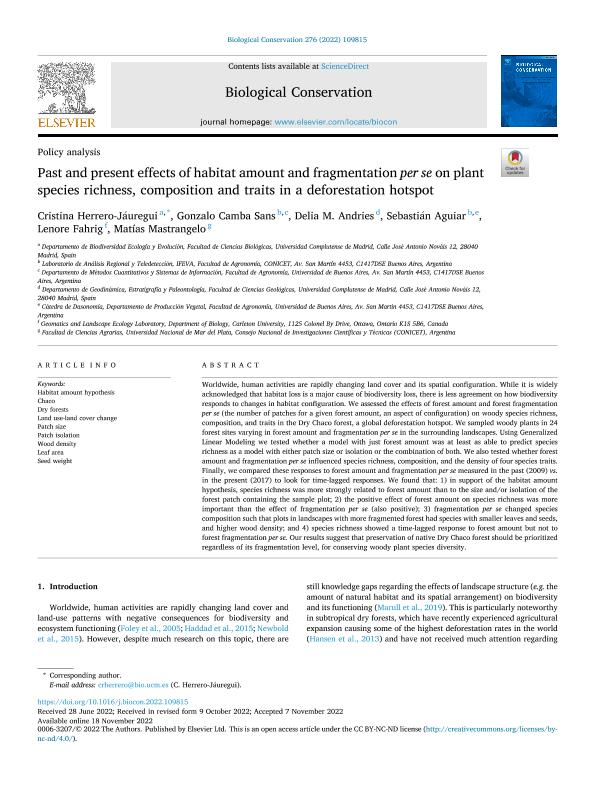Mostrar el registro sencillo del ítem
dc.contributor.author
Herrero Jáuregui, Cristina
dc.contributor.author
Camba Sans, Gonzalo Hernán

dc.contributor.author
Andries, Delia M.
dc.contributor.author
Aguiar, Sebastián

dc.contributor.author
Fahrig, Lenore
dc.contributor.author
Mastrangelo, Matias Enrique

dc.date.available
2023-09-06T14:17:06Z
dc.date.issued
2022-12
dc.identifier.citation
Herrero Jáuregui, Cristina; Camba Sans, Gonzalo Hernán; Andries, Delia M.; Aguiar, Sebastián; Fahrig, Lenore; et al.; Past and present effects of habitat amount and fragmentation per se on plant species richness, composition and traits in a deforestation hotspot; Elsevier; Biological Conservation; 276; 12-2022; 1-14
dc.identifier.issn
0006-3207
dc.identifier.uri
http://hdl.handle.net/11336/210679
dc.description.abstract
Worldwide, human activities are rapidly changing land cover and its spatial configuration. While it is widely acknowledged that habitat loss is a major cause of biodiversity loss, there is less agreement on how biodiversity responds to changes in habitat configuration. We assessed the effects of forest amount and forest fragmentation per se (the number of patches for a given forest amount, an aspect of configuration) on woody species richness, composition, and traits in the Dry Chaco forest, a global deforestation hotspot. We sampled woody plants in 24 forest sites varying in forest amount and fragmentation per se in the surrounding landscapes. Using Generalized Linear Modeling we tested whether a model with just forest amount was at least as able to predict species richness as a model with either patch size or isolation or the combination of both. We also tested whether forest amount and fragmentation per se influenced species richness, composition, and the density of four species traits. Finally, we compared these responses to forest amount and fragmentation per se measured in the past (2009) vs. in the present (2017) to look for time-lagged responses. We found that: 1) in support of the habitat amount hypothesis, species richness was more strongly related to forest amount than to the size and/or isolation of the forest patch containing the sample plot; 2) the positive effect of forest amount on species richness was more important than the effect of fragmentation per se (also positive); 3) fragmentation per se changed species composition such that plots in landscapes with more fragmented forest had species with smaller leaves and seeds, and higher wood density; and 4) species richness showed a time-lagged response to forest amount but not to forest fragmentation per se. Our results suggest that preservation of native Dry Chaco forest should be prioritized regardless of its fragmentation level, for conserving woody plant species diversity.
dc.format
application/pdf
dc.language.iso
eng
dc.publisher
Elsevier

dc.rights
info:eu-repo/semantics/openAccess
dc.rights.uri
https://creativecommons.org/licenses/by-nc-nd/2.5/ar/
dc.subject
CHACO
dc.subject
DRY FORESTS
dc.subject
HABITAT AMOUNT HYPOTHESIS
dc.subject
LAND USE-LAND COVER CHANGE
dc.subject
LEAF AREA
dc.subject
PATCH ISOLATION
dc.subject
PATCH SIZE
dc.subject
SEED WEIGHT
dc.subject
WOOD DENSITY
dc.subject.classification
Ciencias Medioambientales

dc.subject.classification
Ciencias de la Tierra y relacionadas con el Medio Ambiente

dc.subject.classification
CIENCIAS NATURALES Y EXACTAS

dc.subject.classification
Ecología

dc.subject.classification
Ciencias Biológicas

dc.subject.classification
CIENCIAS NATURALES Y EXACTAS

dc.subject.classification
Conservación de la Biodiversidad

dc.subject.classification
Ciencias Biológicas

dc.subject.classification
CIENCIAS NATURALES Y EXACTAS

dc.title
Past and present effects of habitat amount and fragmentation per se on plant species richness, composition and traits in a deforestation hotspot
dc.type
info:eu-repo/semantics/article
dc.type
info:ar-repo/semantics/artículo
dc.type
info:eu-repo/semantics/publishedVersion
dc.date.updated
2023-07-31T15:02:15Z
dc.journal.volume
276
dc.journal.pagination
1-14
dc.journal.pais
Países Bajos

dc.journal.ciudad
Amsterdam
dc.description.fil
Fil: Herrero Jáuregui, Cristina. Universidad Complutense de Madrid; España
dc.description.fil
Fil: Camba Sans, Gonzalo Hernán. Consejo Nacional de Investigaciones Científicas y Técnicas. Oficina de Coordinación Administrativa Parque Centenario. Instituto de Investigaciones Fisiológicas y Ecológicas Vinculadas a la Agricultura. Universidad de Buenos Aires. Facultad de Agronomía. Instituto de Investigaciones Fisiológicas y Ecológicas Vinculadas a la Agricultura; Argentina
dc.description.fil
Fil: Andries, Delia M.. Universidad Complutense de Madrid; España
dc.description.fil
Fil: Aguiar, Sebastián. Consejo Nacional de Investigaciones Científicas y Técnicas. Oficina de Coordinación Administrativa Parque Centenario. Instituto de Investigaciones Fisiológicas y Ecológicas Vinculadas a la Agricultura. Universidad de Buenos Aires. Facultad de Agronomía. Instituto de Investigaciones Fisiológicas y Ecológicas Vinculadas a la Agricultura; Argentina
dc.description.fil
Fil: Fahrig, Lenore. Carleton University; Canadá
dc.description.fil
Fil: Mastrangelo, Matias Enrique. Universidad Nacional de Mar del Plata; Argentina. Consejo Nacional de Investigaciones Científicas y Técnicas; Argentina
dc.journal.title
Biological Conservation

dc.relation.alternativeid
info:eu-repo/semantics/altIdentifier/url/https://www.sciencedirect.com/science/article/pii/S0006320722003688
dc.relation.alternativeid
info:eu-repo/semantics/altIdentifier/doi/http://dx.doi.org/10.1016/j.biocon.2022.109815
Archivos asociados
